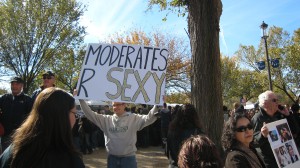In my initial post after the Rally to Restore Sanity, I had promised some more detailed analysis of my experiences in later posts. However, the rally brought up so many interesting ideas that to cover them in one post would tax both my interest and yours. So I’ll be splitting my “coverage” of the event into a few posts, the number to be determined by how much I have to say. But to start in the most obvious place, I’m going to talk a bit more about the actual experience of attending a rally.
 While I won’t claim to be a political activists or a consistent rally attendee, I’ve gone to quite a few political events in Madison, Wisconsin. And I have to say, the mantle of “sanity” imposed on the event appeared to have a real impact on people’s behaviors. With 200,000+ people pouring into the city, there were many opportunities for the event to get out of hand. But for the most part, people remained civil, respectful, and courteous to one another: crowding together on the Metro to squeeze in as many people as possible while resisting the urge to push too aggressively, giving others directions and input about the best way to handle the event, updating others on new information, and just generally being relaxed. When the crowd got unruly – for example, when a reporter who claimed to be from Fox showed up asking questions – any heckling was immediately silenced by others in the crowd, not only telling them to avoid giving Fox any material, but again assuming the mantle of civility. Thus, it really was a “sane” rally, in terms of crowd dynamics at least.
While I won’t claim to be a political activists or a consistent rally attendee, I’ve gone to quite a few political events in Madison, Wisconsin. And I have to say, the mantle of “sanity” imposed on the event appeared to have a real impact on people’s behaviors. With 200,000+ people pouring into the city, there were many opportunities for the event to get out of hand. But for the most part, people remained civil, respectful, and courteous to one another: crowding together on the Metro to squeeze in as many people as possible while resisting the urge to push too aggressively, giving others directions and input about the best way to handle the event, updating others on new information, and just generally being relaxed. When the crowd got unruly – for example, when a reporter who claimed to be from Fox showed up asking questions – any heckling was immediately silenced by others in the crowd, not only telling them to avoid giving Fox any material, but again assuming the mantle of civility. Thus, it really was a “sane” rally, in terms of crowd dynamics at least.
Furthermore, it seemed to be an empowering rally. A lot of the attendees carried signs, which ranged from the comical to the mocking, from the serious to the just plain absurd. And in these signs we saw more of the politically-motivated nature of the rally, as they often were mocking others, especially Tea Party activists. There was some evidence of the “elitism” that others feared would characterize the rally and mobilize the opposition in these signs – and it will be interesting to examine more closely how the rally got covered in the various media outlets. However, even these signs mocking the opposition tended to be relatively civil or adopted humor in their approach – which has been shown to mitigate the negative impact of aggression.
of the rally, as they often were mocking others, especially Tea Party activists. There was some evidence of the “elitism” that others feared would characterize the rally and mobilize the opposition in these signs – and it will be interesting to examine more closely how the rally got covered in the various media outlets. However, even these signs mocking the opposition tended to be relatively civil or adopted humor in their approach – which has been shown to mitigate the negative impact of aggression.
Finally, as I noted before, the rally was an awesome and culturally significant event that I was glad to be a part, but with the unexpectedly large crowds, it was very difficult to hear or see anything. I suspect this is true for many of the other attendees as well, as we gathered around the large television screens and speakers in the far back. Many people appeared to spend the entire rally searching for a better location from which to observe and understand what was occurring.
Altogether, despite the crowd exceeding the initial expectations, the rally was well-executed. The experience of attending a rally of this magnitude with its semi-political purpose was one I’m grateful to have participated in. But I plan to examine the actual content of the rally – and its impact – in future posts. So stay tuned!
“…or adopted humor in their approach – which has been shown to mitigate the negative impact of aggression.”
Hmmm. Why does that sound familiar to me?????